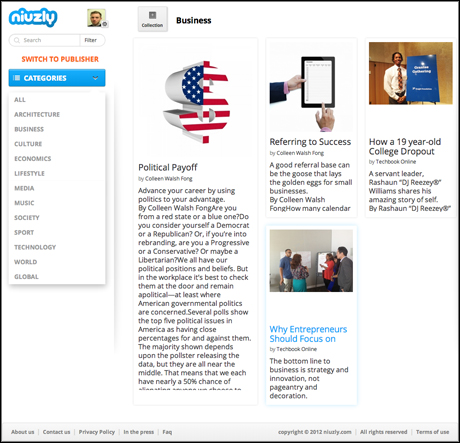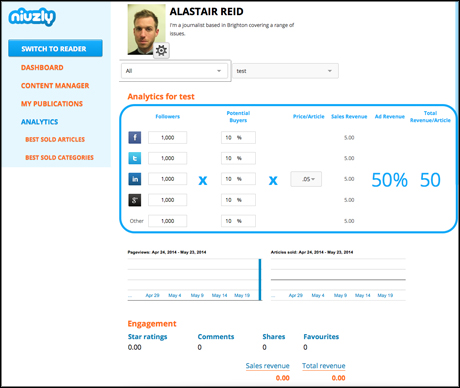
Niuzly, a publishing platform with a built-in micropayment monetisation feature that launched last month, has big plans for the future of publishing.
By giving writers the power to charge for their work directly and readers the option to pay small fees for individual articles, Niuzly founder and chief executive Paul Dinulescu hopes to do away with the large, blanket subscriptions of paywalls for more targeted, personalised payments for content.
"The whole industry is struggling to find a way to monetise," Dinulescu, a self-described "news junkie", told Journalism.co.uk. "Since the internet took off they've been putting content online for free in the hope to get users to buy stuff and make money from advertising, but this model doesn't work."
The problem, he said, is not that people don't want to pay for news or journalistic content but that people are averse to paying through the channels currently offered to them.Why don't you have everything in one place and only pay for what you want to read?Paul Dinulescu, Niuzly
"From a consumer point of view, they don't have the incentive to subscribe because what if you like more than one publication?," continued Dinulescu. "Why don't you have everything in one place and only pay for what you want to read? There's no point in paying for a publication's subscription and hope you can read the whole thing during the year and pay in advance."
This was his frustration upon leaving New York, where he had been an avid reader of US titles but found that he would have to pay large annual subscription fees to continue reading the publications online from abroad.
His solution, from both the readers' and publishers' perspective, is to offer individually priced articles at a nominal fee, of which writers take 80 per cent and a 50 per cent share of ad revenue. Because of administration costs at this early stage, writers will receive their income 45 days after each month once they have earned $300 through their work.

Articles are organised by topic with the first paragraphs available before readers are prompted to pay the designated price. Those with an account add credit through PayPal in packages of $5 to $20, a pot of cash then used to access the rest of the article.
Journalists publish articles from a content management system that allows the author to categorise stories, set a price at five, 10, 20 or 30 cents each, and preview the finished piece on multiple devices before publishing.
On the analytics page for each article the journalist can estimate its potential revenue, calculated by the number of potential buyers among the author's social media contacts and additional ad revenue, and assess the demographics and publishing history of the paying readership so far.

"The first thing you can do is publish to the audience," said Dinulescu, "because who knows you as a writer? Your friends, your family. People have hundreds of thousands of followers on Twitter and Facebook. Does it not make sense to publish to the audience first? Those are the ones that want to hear from you."
Writers can start their own publication within the platform, organising their content on different topics in one place.
At present Dinulescu is focusing on accumulating individual writers from around the world, encouraging them to try Niuzly as a non-exclusive platform for publication and monetisation while publishing the same content for free on other platforms if they wish.
He is especially interested in looking into countries where media outlets may be controlled by the state or large conglomerates, he said, where a platform like Niuzly could give independent journalists more control over their work.
Eventually though, he hopes that large media organisations will also want to publish individual articles through Niuzly, an approach he tried upon founding the company in 2012 but without success.
"They [media organisations] want to innovate but nobody wants to be the first one," he said. "There's a huge community of bloggers that don't get paid. They write for all these big publications for free because they want to have the name and it looks good on the resume."The biggest goal is to educate readers everywhere that it takes money, it takes time, it takes effort to produce contentPaul Dinulescu, Niuzly
Micro payments have long been debated as a potential revenue source for publishers, with The New York Times's David Carr calling on publishers to "invent an iTunes for news", an analogy that Dinulescu also favours to describe Niuzly.
Author, teacher and media commentator Clay Shirky dismissed the idea in 2009, claiming "small payment systems don’t survive contact with online markets", because customers do not like being "nickel-and-dimed", preferring to make larger payments.
However micropayments have proved successful for online gaming, especially on mobile where users are able to pay through their app provider, and new online payment methods regularly reprise the possibility of the concept's application to news.
"We kind of copied the Apple revenue model," said Dunilescu. "But let's get all the freelance journalists who are amazing writers and are looking for a way to actually publish."
And others are also trying to crack the micropayments model for news. In April, for example, a Dutch collective of publishers launched Blendle, a publishing and micropayment platform that offers readers individually-priced and refundable articles.
"The biggest goal is to educate readers everywhere that it takes money, it takes time, it takes effort to produce content and if those people don't get paid they will stop doing it," Dunilescu added.
Free daily newsletter
If you like our news and feature articles, you can sign up to receive our free daily (Mon-Fri) email newsletter (mobile friendly).
Related articles
- 200 speakers you need at your next journalism event to avoid all-male panels
- New app uses geolocation to help local publishers boost ad revenue
- Blendle shuts down micropayment model due to "very limited user base"
- Micropayments on Twitter: good or bad for publisher's business models?
- A toolkit for journalism content creators









